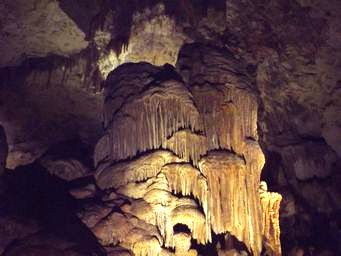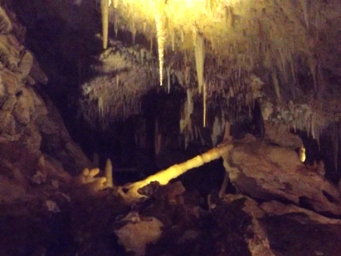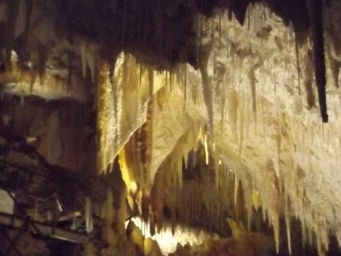Australia So Much to See


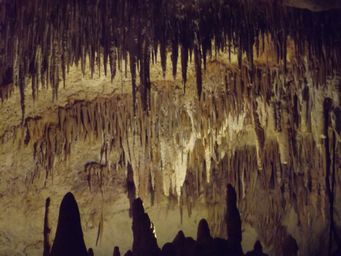
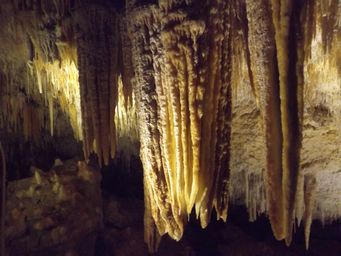
Caves of the Augusta Margaret River area - The Leeuwin-Naturaliste Ridge
The Leeuwin-Naturaliste Ridge in the Margaret River Region is dotted with over 150 limestone caves, most of which are not open to the public. Other caves in Western Australia are listed on Wikipedia Caves of Western Australia, although most of these are not open to the public. Those listed as Augusta, Cowaramup, Margaret River, Witchcliffe, and Yallingup are all in the Leeuwin-Naturaliste karst area.
Those that are readily open to tourists are:
Ngilgi Cave at Yallingup, which was the first cave I ever toured, is the most visited. Even though I was a pre-school child, I still remember the fascination of seeing the formations, walking into a dark cavern and the guide turning a light on The Shawl, the guide telling us to remember that Stalactites are the ones that have to hang on tight and that Stalagmites are the ones that might reach the Stalactites one day. Ngilgi Cave offers a stunning display of stalactite, stalagmite, helictite and shawl formations plus an interpretive area detailing the Cave's rich history. Today you can enjoy semi-guided tours incorporating 350 steps, and a range of other experiences including awesome adventure caving and torchlight tours. Ngilgi Cave is the northernmost cave open to the public in the Leeuwin-Naturaliste karst. This cave was officially opened to the public in December 1900, being the first cave open to visitors in Western Australia. See the Story of Ngilgi.
We visited Jewel Cave which is 37 kilometres south of Margaret River and nine kilometres north of Augusta, this cave sinks to a reachable
depth of 42 metres and is 1.9 kilometres long. It is the largest cave open to the public in Western Australia, but only 40%
has been developed for display. Tours are guided. This tour has 250 steps into and around the caverns. High carbon
dioxide levels are present in Jewel Cave.
Jewel Cave was discovered in 1957 by Augusta local Cliff Spackman who lowered
himself through a small hole in the top to the floor 42 metres below. It was officially opened to the public in May 1960 and Cliff
served as Chief Guide for the next 24 years.
Jewel Cave has one of the longest straw stalactites found in any tourist cave in
the world at 5.4 metres, a huge area of flowstone that resembles a karri forest, and a stalagmite weighing some twenty tonnes. There
are, in addition to stalagmites and stalactites, tectite’s (which run sideways), straws, flowstones, shawls, and the unusual pendulites
(lumps on the ends of straws which form when the straw reaches water level).
In 2011, cavers discovered the footprints
of the extinct Tasmanian tiger in a cave in Western Australia. The extremely rare footprints were found in soft mud in Augusta’s
Jewel Cave while taking water samples in a remote area of the cave. They were discovered right next to where the bones of a
Tasmanian tiger or thylacine were found in the 1960’s.
The man who made the discovery, caver and environment project manager
for Augusta Margaret River Tourism Association Lindsay Hatcher said finding any type of footprint in a cave is extremely rare. "Thylacines
footprints have never been found in any other cave in WA and probably not in any other cave in Australia," Mr Hatcher said.
Animals
can fall through holes in the roof of a cave. If they survive the impact, they are trapped and starve to death.
Striped like a tiger and with powerful jaws that opened up to an unusual 120 degrees, Tasmanian tigers were the size of a kelpie
dog and one of only two marsupials the other a water opossum with pouches in both sexes.
Lake Cave and Cave Works Discovery Centre is eighteen kilometres south of Margaret River along Caves Road. See photos
and description from 2020
At Cave Works Discovery Centre, visitors can walk through a cave model featuring a flowing stream.
Interactive touch screens allow visitors to explore subjects such as cave speleothems (formations), bones of our distant past and
historical information. Universally accessible boardwalks lead to a viewing platform where visitors can glimpse into the depths of
Lake Cave.
Giants Cave is nineteen kilometres south of Margaret River
along Caves Road. Giants Cave is one of the biggest and deepest caves in the Leeuwin-Naturaliste Ridge.
Calgardup Cave is a self-guided unlit cave. Torches, helmets and a safety briefing are provided by the Visitor Centre staff before entering the cave. It is an easy cave to visit with elevated platforms, stairs and railings to descend 27 metres into this 300 metre long cave. A seasonal lake with mirror-like reflections can be seen from spring through to summer. After winter rains when you can also hear the seasonal stream trickling through the cave. Calgardup Cave is thirteen kilometres south of Margaret River along Caves Road.
See our visit to Calgardup Cave 2018.
Mammoth Cave is fifteen kilometres south of Margaret River along Caves Road, and has a self-guided audio tour. The Mammoth Cave has a wheelchair accessible long boardwalk entrance from the valley on the eastern side of the cave into the first chamber of the cave. After the first chamber, there are about 370 steps staged throughout the remainder of the cave, and a climb of 170 steps to exit up through the ridge on the western side of the cave.
Formations
include the Mammoth shawl and the “Karri Forest” flowstone which seems to resemble the unique karri trees of the Augusta Margaret
River region. Mammoth Cave is home to the largest Megafauna (large extinct marsupials) fossil deposits in Australia. Ten thousand
specimens were recovered by the WA Museum in the early 1990s. The jawbone of an extinct marsupial Zygomaturus about the size of a
cow is visible in the wall of this cavern. If you visit during winter, you will see a stream flowing through the cave which
is stained red from natural tannins.
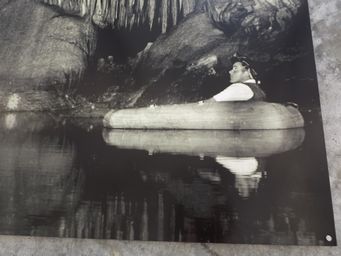
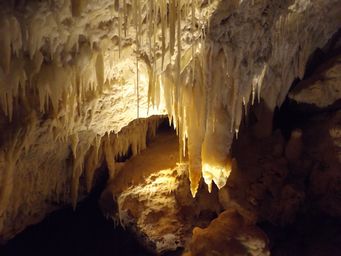
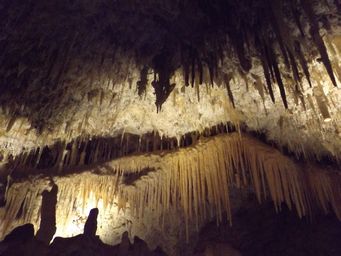
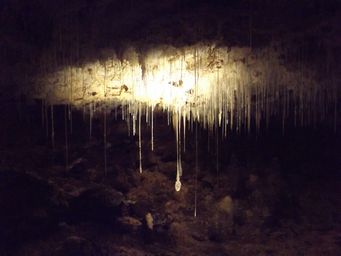
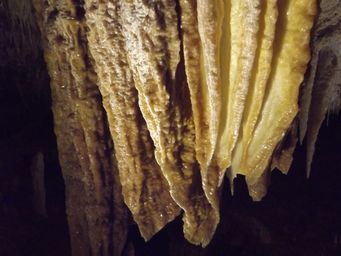
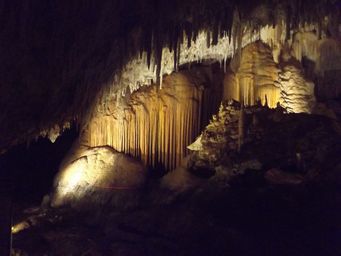
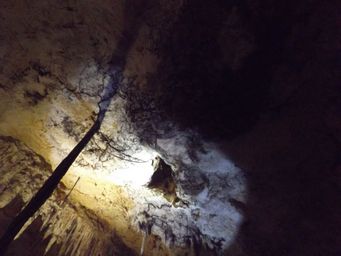
Photo on display of boating in a water filled cave. The water table has lowered so much that Jewel Cave remains a dry cave. Aquatic cave life is at risk with the drying climate diminishing water levels in the Leeuwin-Naturaliste caves.
Jewel Cave was named after a smaller section known as the Jewel Casket and its crystal formations. Here the formation at centre is
called the Frozen Waterfall.
